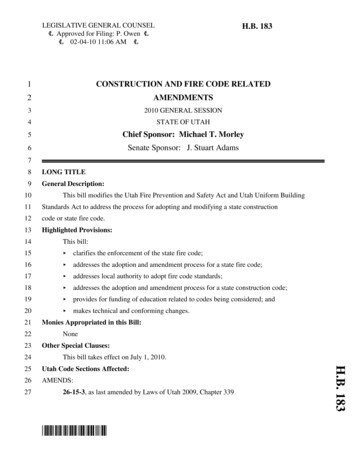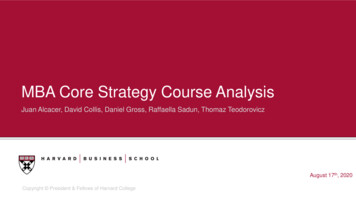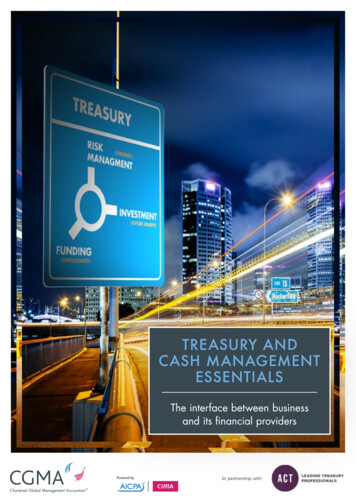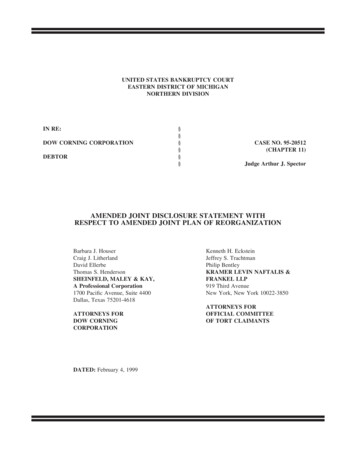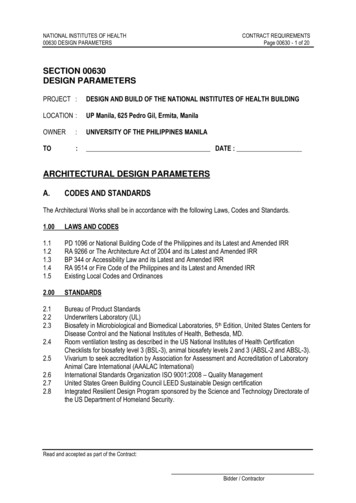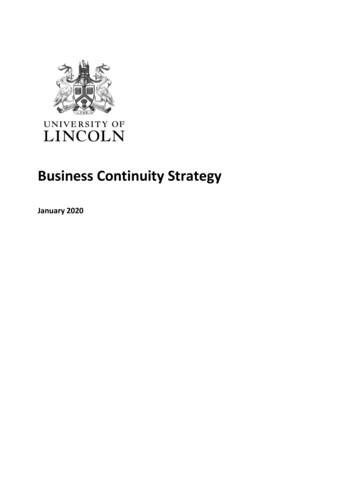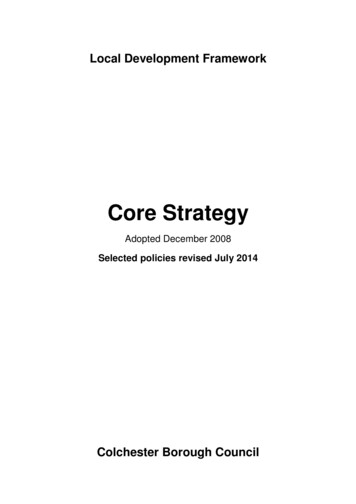
Transcription
Local Development FrameworkCore StrategyAdopted December 2008Selected policies revised July 2014Colchester Borough Council
1
Preface - Revised Core Strategy following Focused ReviewJuly 2014This document was updated in July 2014 as a result of ColchesterBorough Council’s Focused Review of its Local Plan.The National Planning Policy Framework (NPPF), published by theGovernment on 27 March 2012, replaced a considerable amount of planningpolicy previously contained within a number of national policy documents.The consolidated guidance is intended to make the planning system lesscomplex and more accessible, and to promote sustainable growth.The NPPF is a material consideration in the preparation of local plans andalso provides guidance in the determination of planning applications. Thismeans that its publication created a need for local authorities to reconsidertheir intentions for reviewing and developing local planning policies.The Focused Review was an initial, limited, review of policies which could bereadily amended without the need to prepare further extensive evidence inrespect of those specific policies. Only those policies that clearly requiredupdating due to non-compliance with the NPPF were included in this stage.Revisions do not include any amendments to the spatial strategy, housing andemployment targets, or allocations.The Focused Review underwent two stages of consultation to allow forwidespread involvement in the review process, in compliance with theCouncil’s Statement of Community Involvement and the Town and CountryPlanning (Local Development (England) Regulations 2012). The initial Issuesand Options consultation stage, carried out in March – April 2013, provided anopportunity for the Council to outline the areas which it considered needed tobe reviewed. The Council then consulted on revised policies, prior tosubmission to the Secretary of State for examination.The Council is now developing a new Local Plan which will includeamendments to the spatial strategy; housing and employment targets; andsite allocations, as these issues require the support of updated evidence basework. The Full Review is programmed for adoption in 2017.These are the policies that have been amended by the Focused Review: Sustainable development – the Government’s model policy has beenadded, to reflect the NPPF’s presumption in favour of sustainabledevelopment (Core Strategy Policy SD1). Changes to the system of planning obligations and introductionof Community Infrastructure Levy – the text has been modified toreflect latest guidance on planning contributions in relation to both sitespecific and strategic infrastructure improvements (Core StrategyPolicies SD2 and SD3).2
Affordable housing – the policy on affordable housing is modified tocomply with the NPPF’s requirements to pay careful attention toviability and costs in plan-making and decision-taking, including thechange in economic circumstances since the original policy wasadopted in 2008 (Core Strategy Policy H4). Housing density and mix - tables on density and housing mix havebeen deleted because they do not adequately reflect particular siteconstraints and requirements, and, accordingly, may not have fullyaccorded with the greater flexibility provided in the NPPF (CoreStrategy Policies H2 and H3). Gypsies and travellers –The changes to the Gypsy and TravellerPolicy wording clarify how the Local Plan will treat gypsy and travellerapplications prior to the adoption of a new Local Plan policy, which willbe based on updated evidence (Core Strategy Policy H5). Neighbourhood Planning – policies now include references, whereappropriate, to the new system of Neighbourhood Plans (Core StrategyPolicy ENV2). Rural exception sites – policies have been modified to allow for alimited degree of market housing on rural exception sites to enable thedelivery of affordable housing (Core Strategy Policy H4 and ENV2). Rural workers’ housing – a new Core Strategy Policy on ruralworkers housing is included, to provide guidance that is no longerprovided nationally (Core Strategy Policy H6). Minor changes – minor changes include updates to ensureconsistency with the NPPF; removal of references to supersededPlanning Policy Statements and Guidance Notes.All other policies remain unchanged, until they are replaced through the FullReview of the Local Plan.3
Contents:Executive Summary41. Introduction82. Spatial Portrait123. Vision and Objectives224. Spatial Strategy255. Core Policies37**5.1 Sustainable Development Policies5.2 Centre and Employment Policies5.3 Housing Policies5.4 Urban Renaissance Policies5.5 Public Realm Policies5.6 Transport and Accessibility Policies5.7 Environment and Rural Communities Policies5.8 Energy, Resources, Waste, Water & Recycling Policy****6. .E.GlossarySettlement HierarchyMonitoring Targets IndicatorsReferencesSaved Local Plan policies superseded by the Core Strategy** Selected policies revised following July 2014 Focused Review4
Executive SummaryIntroductionColchester is a diverse and growing Borough, with a vibrant town centre,attractive villages and important natural landscapes. Over the next 15 yearsthe Borough will face many challenges, such as housing growth, evolvingeconomic trends and the need for more sustainable transportation.The Borough Council is preparing a Local Development Framework (LDF) toestablish a long-term strategy to manage development, provide services,deliver infrastructure and create sustainable communities. The Core Strategywill be the overarching document in the LDF that sets the strategic context forall the other development plan documents.Stages of the Core StrategyThe adopted Core Strategy is the result of a 3 stage consultative process. TheCore Strategy Issues and Options document (Stage 1) was published inMarch 2006. This was followed by the Core Strategy Preferred Optionsdocument (Stage 2) in November 2006, and an amendment to the preferredoptions in July 2007. At each of these stages the document has beenconsulted upon for a 6-7 week period and improvements have been made tothe Core Strategy in response to submissions, sustainability appraisal, newevidence and changes to national policy. The submission Core Strategy(Stage 3) was published for consultation in November 2007 with anyrepresentations received being considered by the Planning Inspector duringExamination in Public. The hearing sessions for Examination in Public wereheld during June and July 2008, and the Inspector’s binding report received inOctober 2008. The Core Strategy was adopted by full Council on the 11thDecember 2008.Vision and ObjectivesThe Spatial Vision sets out where we want to be in 2021 and articulatesambitious aspirations for Colchester to become a sustainable and prestigiousregional centre, surrounded by thriving villages and countryside. The SpatialVision is informed by the Sustainable Community Strategy, and the objectivesprovide more specific direction for the Spatial Strategy and Core Policies.Spatial StrategyThe Spatial Strategy provides an overview or summary of the Core Strategyand establishes the context for the Core Policies. The spatial elements of theStrategy are also illustrated in the Key Diagrams.The Spatial Strategy emphasises the importance of the Town Centre andregeneration. The Strategy directs development towards the most accessibleand sustainable locations, and plans for the provision of transport,employment and community facilities to support the following growth areas.5
The Town Centre will be the focus of regeneration activity to deliver 2000 newhomes, 67,000sqm of retail floorspace and 40,000sqm of office floorspace.The regeneration of St Botolphs and the North Station area will also deliverkey outcomes, including the Firstsite Building, Cultural Quarter and NorthStation gateway.The North Growth Area will accommodate 6200 homes, including asustainable urban extension and the regeneration of the former SeverallsHospital. This growth area will also deliver the Community Stadium, NorthTransit Corridor, A12 junction, and Park and Ride.The East Growth Area will regenerate the former harbour to accommodate2600 new homes, as well as delivering the East Transit Corridor, HytheStation improvements, the University Research Park, and expansion of theUniversity itself.The South Growth Area will deliver a new Army Garrison and regenerate theformer garrison to accommodate 3000 homes within an urban village withgood links to the Town Centre.The Stanway Growth Area will also be subject to significant developmentduring the life of the plan, including 1800 homes, employment development,and road improvements.Tiptree, Wivenhoe and West Mersea are the main district settlements outsideof Colchester Town. These settlements will accommodate about 1600 homesand provide shops and services to their surrounding rural hinterland. Thedistinct local character of other villages will be protected and local housingand employment development will be supported to meet community needs.Core PoliciesThe policies in the Core Strategy provide the overarching policy direction forthe Local Development Framework, and for the delivery of development,infrastructure, facilities and services in Colchester to 2021.Sustainable DevelopmentThe Strategy establishes a Settlement Hierarchy to guide developmenttowards the most sustainable locations. These development locations will becoordinated with transport infrastructure and the provision of communityfacilities, shopping, employment and open space to create sustainablecommunities.The Core Strategy seeks to provide excellent health, education, culture andleisure facilities to meet the needs of Colchester’s growing community. Majorcommunity facilities (including the University of Essex and the ColchesterGeneral Hospital) will form key components of the growth areas and will bebetter connected by Transit Corridors. The Strategy also seeks to deliver newcommunity facilities, including the Firstsite Building and Community Stadium.6
Centres and EmploymentAchieving a prestigious regional centre and sustainable communities requiresthe enhancement of our Town Centre as well as other local centres. The CoreStrategy establishes a hierarchy that secures the important role of the TownCentre and encourages the regeneration of Urban Gateways to Colchester(e.g. North Station). The Core Strategy also promotes the enhancement ofDistrict and Local Centres to support communities with local employment,shops and services.Strategic Employment Zones have also been identified to accommodatebusiness development at locations to the north, east and west of ColchesterTown that are well supported with infrastructure.HousingColchester Borough needs to accommodate a minimum of 17,100 new homesbetween 2001 and 2021, and at least an additional 1,710 homes by 2023.Over two-thirds of this housing is already accounted for through existingallocations, permissions and completions. In broad terms, the majority ofhousing development in the Borough will be accommodated at the followinglocations: Town Centre (2000) North Growth Area (6200, including 2200 greenfield allocations) East Growth Area (2600) South Growth Area (3000) Stanway Growth Area (1800, including 800 greenfield allocations)Housing developments will need to provide 35% affordable housing andprovide a mixed of housing to meet the diverse needs of the community.Urban RenaissanceThe Core Strategy seeks to maximise the potential of the existingregeneration areas and stimulate a broader urban renaissance throughout theTown Centre. To help deliver this urban renaissance tourism will be supportedand promoted. The Core Strategy also seeks to protect the historic characterof the Borough whilst securing high standards of urban design in newdevelopments.Public RealmCreating a high quality public realm, including parks, squares and streets, isintegral to the success of sustainable communities, and is therefore a keyelement of the Core Strategy.The Strategy seeks to improve the street environment and calm traffic inurban areas to attract residents to local shops, schools, parks and bus stops.Existing parkland and green links will be enhanced, and new open space willbe acquired at appropriate locations, to meet the recreational needs ofColchester’s growing community.7
Transport and AccessibilityThe key aims of the transport strategy and policies are to improveaccessibility and promote sustainable travel behaviour. Improved access toshops, employment and services can be achieved through a long-termstrategy of coordinating land use and transport. The Strategy seeks tocoordinate the following elements in order to improve accessibility and createsustainable communities: Support development at accessible locations to reduce the need totravel. Create people-friendly streets and encourage walking and cycling. Improve the public transport network with Transit Corridors, Park andRide, and quality gateways/interchanges. Improve the strategic road network and manage car traffic and parkingin urban areas. Support rural communities with demand responsive transport services. Travel planning and improved public informationEnvironment and Rural CommunitiesThe natural and historic environment, countryside and coastline will beconserved to protect the Borough’s diverse history, archaeology, geology, andbiodiversity. Development will be directed away from sites of landscape andconservation importance and land at risk from flooding. The unique characterof Colchester villages will be protected, with only limited developmentsupported to meet identified needs for local employment, affordable housingand community facilities. Tourism that is appropriate to the local environmentand context will be supported and promoted.Energy, Resources, Waste, Water and RecyclingEstablishing sustainable communities in Colchester requires carefulmanagement of our energy, resources and waste. The Strategy will promoteenvironmentally sustainable developments that are designed to: Utilise renewable energy sources. Reduce household energy and water consumption. Encourage the recycling of waste.Implementation and MonitoringThe Spatial Strategy and the Spatial Policies will be implemented through thefurther development of the Local Development Framework, by Councilworking with its partners, and through the planned investment of private andpublic resources.Continual plan review is a fundamental element of the new planning system.The Borough Council will undertake annual monitoring of the implementationof the Core Strategy, and of other parts of the LDF as they are developed,and will amend documents as required.8
1. IntroductionColchester is a diverse and growing Borough, with a vibrant town centre,attractive villages and important natural landscapes. Over the next 15 yearsthe Borough will face many challenges, such as housing growth, evolvingeconomic trends and the need for more sustainable transportation. Toaddress these challenges, Colchester Borough Council is preparing a LocalDevelopment Framework (LDF) to meet the needs of current and futuregenerations whilst also protecting and enhancing the environment andpeople’s quality of life.1.1 The Local Development FrameworkThe Local Development Framework (LDF) will plan, monitor and managefuture growth and change in Colchester Borough up to 2021. While theprevious Local Plan system focused on development control, the LDF willcover a broader range of spatial issues that contribute towards sustainablecommunities, including issues such as transport, employment and recycling.The Colchester LDF will comprise a range of Local Development Documents(see Figure 1), including the following: Local Development SchemeStatement of CommunityInvolvementCore StrategyDevelopment PoliciesSite AllocationsArea Action Plans.LDF ProcessStrategy and PolicyThe Core Strategy is the central document of the Local DevelopmentFramework, and provides the broad policy directions to guide the otherdocuments in the LDF. The Core Strategy will establish a long-term strategyto manage development, provide services, deliver infrastructure and createsustainable communities. It comprises the spatial vision and objectives, aspatial strategy, core policies and a section setting out how we will implementand monitor the strategy. Its effectiveness will be monitored on an annualbasis through the Annual Monitoring Report and it will be reviewed whennecessary.The Council has undertaken a Sustainability Appraisal and an AppropriateAssessment of the Core Strategy to evaluate the sustainability of theproposed strategy, policies and options.9
Figure 1. Local Development Framework1.2 Conformity with Other Policies and StrategiesThe new planning system requires the Core Strategy and the LDF to beconsistent with national planning policy, the draft East of England Plan andthe Community Strategy. All subsequent Development Plan Documents andSupplementary Planning Documents in the LDF will also need to be inconformity with the Core Strategy. Accordingly, the Core Strategy has beenprepared in conformity with the following policies and strategies.National Planning PolicyNational planning policy is primarily set forth in Planning Policy Guidance(PPG) which is progressively being updated and issued as Planning PolicyStatements (PPS). PPS 1 summarises six key principles of sustainableplanning which this Core Strategy seeks to follow: Sustainable communities – Development plans should ensure thateconomic, social, and environmental objectives are achieved togetherover time Development plans should ensure that they contribute to globalsustainability by addressing the causes and potential impacts ofclimate change Development plans need to take a spatial approach. This means thatthey need to integrate traditional land use planning policies with otherpolicies and programmes which influence the nature of places and howthey function; Planning policies should promote high quality inclusive design; Development plans should contain clear, comprehensive, and inclusiveaccess policies10
Community involvement is an essential element of the planningprocessRegional PlanningThe East of England Plan (EEP) (published May 2008) is the Regional SpatialStrategy for Colchester Borough and the LDF needs to be in generalconformity with it. The EEP outlines a range of policies and targets relevant tospatial planning in Colchester. The most notable of these include: Identification of Colchester as a Key Centre of Development andChange. (Policy SS3) Identification of Colchester as a priority area for regeneration. (PolicySS5) The need to facilitate the provision of 20,000 new jobs in the EssexHaven Gateway including approximately 14,200 new jobs in Colchesteras specified in earlier drafts of the East of England plan. (Policy E1 andHG2) The need to identify Strategic Employment Sites in Colchester. (PolicyE3) Identification of Colchester’s Town Centre as a Regional Centre forretail and other town centre purposes. (Policy E5) The need to provide a minimum of 17,100 new homes between 2001and 2021, and at least 1710 additional homes by 2023. (Policy H1 andHG1) Identification of Colchester as a Regional Transport Node. (Policy T5)The Core Strategy is consistent with the East of England Plan and seeks toimplement the policies and targets as they relate to Colchester Borough.Colchester also has many unique spatial issues that are not identified in thedraft East of England Plan that will be addressed by the Core Strategy.Colchester Borough forms part of the Haven Gateway sub region, which hasbeen recognised as a ‘New Growth Point’. This special status will help delivercritical funding for vital infrastructure and development projects through along-term partnership between Colchester Borough, the Haven GatewayPartnership and Communities and Local Government (CLG).The Core Strategy is also consistent and supportive of the Regional CitiesEast (RCE) partnership. The RCE objectives for housing, prosperity, jobs andthe environment can all be advanced through the Core Strategy and the LDF.Community StrategyThe LDF provides the primary means of delivering the spatial elements ofColchester’s Sustainable Community Strategy. The Community Strategy wasprepared by the public, private and community partners forming theColchester Local Strategic Partnership to set a long-term vision for thecommunity of Colchester. The Community Strategy and the LocalDevelopment Framework share a commitment to the development ofobjectives through community consultation and stakeholder involvement.11
Accordingly, the Core Strategy builds on the Strategy’s Vision for Colchesterin 2020:Colchester, excelling as a prestigious regionalcentre that is: an iconic destination for culture and learningnationally and internationally renowned for sustainable economic growth and therefore a place where everyone has theopportunity to achieve their full potential.Reaching across all these goals is a commitment in the SustainableCommunity Strategy to carbon reduction. For the Borough Council, thismeans ensuring that all its strategies, plans and budgets, including the LocalDevelopment Framework, are designed with the goal of reducing theBorough’s carbon footprint.More specifically, the Core Strategy will assist in the delivery of theSustainable Community Strategy priorities (Table 1) which support the abovevision.Table 1 – Delivery of the Community StrategyCommunity StrategyCore Strategy PolicyPrioritiesTransportHeritage & CultureLondon 2012Business & EmploymentLife OpportunitiesAccessibility and Changing Travel Behaviour(TA1)Walking and Cycling (TA2)Public Transport (TA3)Roads and Traffic (TA4)Parking (TA5)Regeneration (UR1)Built Design and Character (UR2)Community Facilities (SD3)Environment (ENV1)Community Facilities (SD3)Open Space (PR1)Centres and Employment Classification andHierarchy(CE1)Mixed Use Centres (CE2)Employment Zones (CE3)Community Facilities (SD3)Housing Diversity (H3)Affordable Housing (H4)12
2. Spatial Portrait2.1 Spatial PortraitLocation and External LinkagesThe Borough of Colchester lies in a key gateway location between the UK andmainland Europe, with access to the rest of Europe via the nearby Ports ofHarwich and Felixstowe to the east and Stansted Airport to the west. The farreaching effect of London as a world city extends to Colchester, 70 milesdistant, with some businesses and commuters locating in Colchester due toits access to the jobs and services of London. Colchester’s prime identity,however, is as a major regional centre with significant employment activity,cultural facilities, educational institutions, retail outlets and visitor attractions.The main town of Colchester serves as a centre not only for the Borough butfor a much wider area of North East Essex, with residents of Braintree,Maldon and Tendring districts travelling into the town to work, shop and useits community facilities. The Borough’s identity is also shaped by its extensivevalued countryside areas and urban green spaces as well as its historicsmaller settlements including Stanway, Tiptree, West Mersea, Wivenhoe,Dedham, and Rowhedge . Colchester has joined with neighbouring Essex andSuffolk authorities in the Haven Gateway partnership to make the most of itslocational advantages through targeted programmes of infrastructureprovision, new sustainable development, business development and trainingfor local people.PopulationAll People 2001 CensusAll People mid-2006- 0-14 years- 15-64 years- 65 years 155,800170,80028,900117,20024,800Mid-2006 Population Estimates, ONS. Crown Copyright, 2007.Ethnic Groups% of resident population in ethnic groups, 2001:- White- Mixed- Asian or Asian British- Black or Black British- Chinese or other96.21.21.20.51.0Census 2001, ONS. Crown Copyright, 2007.Population and HouseholdsColchester’s growing population reflects the overall upward trend in the SouthEast region which has been fuelled by economic growth. In the last fiveyears, the population has increased rapidly by 15,000 as detailed above. Thelargest growth is expected to be the older age groups (60 ), while growthlevels are expected to decline in the younger ages groups (19 and under),with consequent effects on the economy and social provision in the Borough.House building rates have recently been high to keep pace with the growing13
population pressure, but there remains a gap in delivering sufficient quantitiesof affordable housing. Designation of the Haven Gateway as a new GrowthPoint in 2006 reflects the fact that meeting agreed targets is a challengemeriting additional support to ensure sustainable growth is matched withadequate infrastructure provision.Housing & HouseholdsNumber of households in 2001% of households in 2001:- Owner occupied- Social rented housing- Privately rented or living rent freeAverage household size, 200163,70672.3415.2812.382.37Census 2001, ONS. Crown Copyright, 2007.Average number of homes built per annum (between 2001 and 2005)824CBC Housing Trajectory, 2005.Heritage and HabitatColchester, Britain’s ‘Oldest Recorded Town’, recorded by Pliny the Elder inAD 77, has a rich and diverse history dating back to the Iron Age. The town’spresent character reflects this heritage, including its period as the Romancapital of Britain, its importance as a wool and cloth centre in medieval andTudor times, and its focus as a hub for Victorian and 20th century industry.The numerous archaeological sites, historic buildings, and conservation areasin the Borough are a focus for preservation and enhancement. Landmarksthat give Colchester its unique character include the remnants of the TownWall encircling the historic core, the Castle and Castle Park in the heart of theTown Centre, and ‘Jumbo’, the Victorian water tower. The town is alsodefined by its hilltop setting and the green corridor through the Town providedby the River Colne.Surrounding the town of Colchester is an ecologically rich rural and coastalenvironment. Many sites are recognised for their value by international andnational designations, including the coastal and estuary areas in the southeast and the Dedham Vale Area of Outstanding Natural Beauty in the north ofthe Borough. The surrounding villages also have a rich historical heritage,including the seafaring communities of Mersea and Wivenhoe, the formerwool town of Dedham and the jam-making centre of Tiptree.Heritage & HabitatNumber of conservation areasNumber of listed buildingsNumber of scheduled monuments221,60040CBC Annual Monitoring Report, 2006.Economic Activity and ProsperityIn recent years there has been a change in the structure and type ofemployment within Colchester, in common with many other UK towns, with amove away from manufacturing and agriculture towards the service industry.In rural areas and small towns and villages, economic activity has shifted14
away from agriculture towards a more diverse range of small enterprises andtourist related business.The Garrison and the University of Essex are two noteworthy majoremployers that will continue to play a major role in the Borough throughout theplan period and beyond. The University of Essex is also promoting a majorResearch and Science park adjacent to the campus which, when developedin the near future, will be a significant contributor to the borough and subregional economy.While unemployment levels in the Borough as a whole are lower than nationalaverages, there are wide variations in prosperity and there are pockets ofdeprivation in parts of both the towns and rural areas. Parts of St Anne’s, StAndrew’s and Harbour wards are classified as ‘seriously deprived’ becausethey are amongst the 20% most deprived areas in England.Economic Activity & ProsperityAll people aged 16 to 74 years, 2001Number of 16 to 74 year olds working in the service industry, 2001% of 16 to 74 year olds who are:- Employed- Unemployed- students- Retired- Others113,77159,28863.52.38.412.618.7Census 2001, ONS. Crown Copyright, 2007CommunityThe community has access to a wide range of publicly run services andfacilities which will need to be enhanced in line with future development.Colchester General Hospital is expanding and consolidating to better servethe needs of the growing population, and its services are complemented by arange of primary care facilities throughout the Borough. The Borough’seducational facilities comprise a range of primary and secondary schools,while higher education provision consists of two further education colleges(Colchester Sixth Form College and the Colchester Institute) and theUniversity of Essex. Recreational facilities include a range of parks, a leisurecentre, and four multi-activity centres. Regeneration plans include a newfootball stadium to be built in the North Colchester area and a new Firstsite(Visual Arts Facility) which will provide a focal point for the redevelopment ofthe St. Botolph’s quarter.EducationNumber of maintained schools- Primaries- Secondary- Special7964114Essex County Council, 2005.% of population with a degree or other form of higher education, 2001% of the population with no qualifications, 200119%25%Census 2001, ONS. Crown Copyright, 2007.15
HealthLife Expectancy:- Males- Females% of people describing their health as ‘not good’% of people with a limiting long-term illness% of people providing unpaid care78 years82 years7.216.09.3Census 2001, ONS. Crown Copyright, 2007TransportationColchester has been designated as a Regional Transport Node in the East ofEngland Plan, which acknowledges the importance of its transport linksincluding those to London, Stansted Airport, and the ports of Harwich andFelixstowe. One of the biggest challenges for Colchester is road traffic growthand the dominance of the car as the main mode of travel. Significantcongestion can occur during peak times within Colchester on the limi
The adopted Core Strategy is the result of a 3 stage consultative process. The Core Strategy Issues and Options document (Stage 1) was published in March 2006. This was followed by the Core Strategy Preferred Options document (Stage 2) in November 2006, and an amendment to the preferred options in July 2007.

